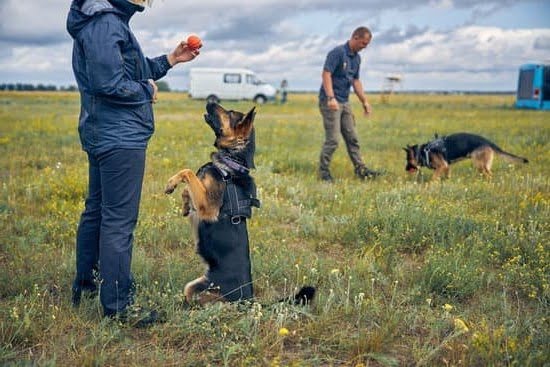Can your dog be trained as a service dog? Many people wonder about the possibility of turning their beloved pet into a dedicated service companion. Understanding the role of a service dog is crucial in determining whether or not your furry friend has what it takes to fulfill this important responsibility. From providing assistance to individuals with disabilities to offering emotional support, service dogs play a vital role in enriching the lives of their handlers.
The distinction between a pet and a service dog goes beyond mere companionship. Service dogs are extensively trained to perform specific tasks that aid individuals with physical, mental, or emotional disabilities. Whether it’s guiding the visually impaired, alerting those with medical conditions, or providing comfort and support during times of distress, these highly skilled animals are indispensable to their handlers.
Qualities and skills are essential for any successful service dog. Obedience, intelligence, good temperament, focus, and ability to learn are just some of the key characteristics that make a great candidate for service dog training. Additionally, depending on the type of service required, certain breeds may exhibit natural traits that are advantageous in fulfilling specific roles as service dogs.
The Difference Between a Pet and a Service Dog
Service dogs play a crucial role in assisting individuals with disabilities to live more independently. It is essential to understand the key differences between service dogs and pets. While pets provide companionship and emotional support, service dogs are specially trained to perform specific tasks that help their handlers with daily activities.
One of the main differences between a pet and a service dog is their level of training and skills. Pets are often trained for basic commands and behavior, while service dogs undergo extensive training to perform tasks such as guiding individuals with visual impairments, alerting someone with hearing loss to sounds, pulling a wheelchair, or retrieving medication for someone with mobility issues.
Another significant difference is the legal status and access rights. Service dogs are granted specific legal protections under the Americans with Disabilities Act (ADA) that allows them to accompany their handlers in public places where pets are not typically allowed. This includes restaurants, buses, taxis, stores, hospitals, and other public accommodations.
Additionally, the relationship between pet owners and their animals is usually based on love and companionship, while the bond between a service dog and its handler is one of cooperation and mutual assistance. Service dogs are trained to focus on their handler’s needs while remaining calm and attentive in different environments. Understanding these distinctions can help individuals make informed decisions about whether they should train their dog for service work or keep them as a beloved pet.
| Service Dogs | Pets |
|---|---|
| Extensive training for specific tasks | Basic obedience training |
| Legal protection under ADA | No legal rights for public access |
| Task-oriented relationship with handler | Companionship-focused relationship with owner |
Qualities and Skills Needed for a Service Dog
For a dog to qualify as a service dog, they must possess specific qualities and skills that enable them to perform their duties effectively. These dogs are not just pets; they are working animals with important responsibilities and tasks. Some of the essential qualities include intelligence, alertness, obedience, and adaptability. Service dogs must also be emotionally stable, calm, and friendly in various situations and environments.
In addition to these qualities, service dogs require certain skills to assist individuals with disabilities. These can include guiding the blind or visually impaired, alerting deaf individuals to sounds, pulling a wheelchair, retrieving objects, providing stability support for those with mobility issues, and even providing emotional support for people with psychiatric disabilities. Other specialized tasks may include detecting seizures or changes in blood sugar levels for people with diabetes.
It is important to note that not all dogs have the temperament or physical ability to become service dogs. The selection process involves thorough assessments by trainers or organizations specializing in service dog training. Different organizations may have specific criteria for the breeds they work with based on their intended work as service dogs.
| Qualities | Skills |
|---|---|
| Intelligence | Guiding the blind or visually impaired |
| Alertness | Alerting deaf individuals to sounds |
| Obedience | Pulling a wheelchair |
| Adaptability |
The Types of Service Dogs
The role of service dogs in our society is diverse and essential, as they have been trained to provide assistance and support to individuals with specific needs. There are several types of service dogs, each with their unique skills and responsibilities.
Guide Dogs
Guide dogs, also known as seeing-eye dogs, are trained to assist individuals who are blind or visually impaired. These highly skilled dogs are trained to navigate obstacles, follow directional commands, and ensure the safety of their handlers while traveling. They provide vital support for individuals with visual impairments, allowing them to move freely and independently.
Hearing Dogs
Hearing dogs are trained to assist individuals who are deaf or hard of hearing. These dogs alert their handlers to important sounds such as doorbells, alarms, or someone calling out their name. They play a crucial role in enhancing the quality of life for individuals with hearing impairments by providing them with auditory cues that they would otherwise miss.
Service Dogs for Physical Disabilities
Service dogs for physical disabilities are trained to assist individuals with mobility limitations or physical impairments. These dogs may be tasked with retrieving objects, opening doors, turning lights on and off, or providing stability and balance support while walking. They play an integral role in helping their handlers carry out daily tasks independently.
These different types of service dogs showcase the versatility and importance of these animals in supporting individuals with various needs. Each type of service dog undergoes specialized training to develop the specific skills necessary for assisting their handlers effectively in different situations.
Can Any Dog Be Trained as a Service Dog?
A common question among dog owners is whether or not any dog can be trained as a service dog. The answer to this question is not a simple “yes” or “no.” While many different breeds and sizes of dogs can potentially be trained as service animals, there are certain qualities and skills that are needed for a dog to effectively serve in this important role.
Physical and Mental Qualities
Not every dog is cut out to be a service animal. Service dogs need to have the right temperament, intelligence, and physical abilities to perform their duties effectively. They must be even-tempered, non-aggressive, and capable of remaining calm in various situations. In addition, they need to have the physical stamina to work long hours and complete tasks that may require significant physical effort.
Breed and Size Considerations
While there are no specific breed requirements for service dogs, some breeds are more commonly used due to their inherent traits such as intelligence, loyalty, and trainability. Breeds like Labrador Retrievers, Golden Retrievers, and German Shepherds are often chosen for their suitability as service animals.
However, mixed-breed dogs can also excel in this role. It’s important to note that the size of the dog can impact its ability to perform certain tasks – smaller breeds may not be able to assist with mobility-related tasks that larger breeds can handle.
The Role of the Handler
Ultimately, the success of any dog as a service animal depends on the dedication and consistency of its handler during the training process. Many different factors contribute to a dog’s ability to become a service animal, including environment, socialization, and early training experiences. Therefore, anyone considering training their dog as a service animal should consult with professional trainers or organizations experienced in this type of specialized training.
The Training Process for Service Dogs
Training a dog to become a service dog is an intensive and ongoing process that requires time, dedication, and patience. Service dogs play a crucial role in assisting individuals with disabilities, so it is essential that they are properly trained to perform their duties. The training process for service dogs typically involves the following steps:
- Basic Obedience Training: This foundational training includes commands such as sit, stay, come, and heel. Service dogs must have excellent obedience skills to follow commands reliably in various situations.
- Task-Specific Training: Depending on the type of service dog needed, specific tasks such as retrieving items, opening doors, providing balance support, or alerting to medical issues may be taught. Each task is tailored to meet the individual needs of the handler.
- Socialization: Service dogs need to be well-socialized to different environments, people, and other animals. They must remain calm and focused in various public settings while working with their handlers.
Service dog training can be conducted by professional trainers or individuals who have experience in canine behavior and training. The process can take several months to years, depending on the complexity of tasks required and the individual capabilities of the dog. Consistent practice and reinforcement are key elements of successful service dog training.
Ultimately, the goal of the training process is for the service dog to provide reliable assistance with daily tasks while maintaining good behavior and focus on their handler’s needs. It’s important for both trainers and handlers to understand that ongoing training and support are necessary throughout the life of a service dog.
Legal Requirements and Regulations for Service Dogs
When it comes to training a dog to become a service dog, it’s important to understand the legal requirements and regulations that come with this responsibility. In the United States, the Americans with Disabilities Act (ADA) protects the rights of individuals with disabilities who rely on service dogs for assistance. Here are some key legal requirements and regulations for service dogs:
- Eligibility: According to the ADA, a service animal is defined as a dog that has been individually trained to do work or perform tasks for an individual with a disability. The tasks performed by the dog must be directly related to the person’s disability.
- Access Rights: Service dogs are granted public access rights, allowing them to accompany their owners in places where pets are not typically allowed, such as restaurants, stores, and public transportation.
- Documentation: While there is no requirement for service dogs to be registered or certified, some organizations provide identification cards or vests for these animals. However, businesses and public entities cannot require these items as proof of a service dog’s status.
It’s important for individuals training their dogs to understand and comply with these legal requirements and regulations in order to avoid any issues when taking their service dog out in public. Violating these laws can result in consequences for both the owner and the establishment.
Overall, it’s crucial for anyone considering training their dog as a service animal to familiarize themselves with the legal aspects involved. By understanding the rights and responsibilities associated with having a service dog, individuals can ensure that they are in compliance with the law while also reaping the benefits of having a well-trained companion by their side.
Benefits and Responsibilities of Having a Service Dog
Having a service dog can bring numerous benefits to individuals with disabilities or medical conditions. These specially trained animals provide assistance and support in performing daily tasks, offering emotional comfort, and even detecting medical emergencies. Service dogs can significantly improve the quality of life for their handlers, making it easier for them to navigate the challenges they face on a daily basis.
However, having a service dog also comes with significant responsibilities. It is important for handlers to understand that caring for a service dog requires time, effort, and dedication. This includes ensuring that the dog receives proper training and care, providing necessary veterinary care, and meeting the dog’s physical and emotional needs. Additionally, handlers must be prepared to advocate for their rights as service dog owners and educate others about the role of these animals in their lives.
One of the key benefits of having a service dog is the increased independence and sense of security it provides. For individuals with mobility impairments or medical conditions such as epilepsy or diabetes, having a service dog by their side can mean being able to live more independently and confidently. Service dogs are trained to perform specific tasks that assist their handlers in various ways, allowing them greater freedom and autonomy in their daily lives.
Conclusion
In conclusion, the decision to train your dog as a service dog is not one to be taken lightly. It requires careful consideration of your dog’s abilities, the specific needs you have for a service dog, and the legal and ethical responsibilities that come with having a service animal.
While any dog has the potential to be trained as a service dog, it is important to recognize that not every dog will have the necessary qualities and skills needed for this role.
It is essential to understand the differences between a pet and a service dog, as well as the various types of service dogs and their specific functions. Additionally, the training process for service dogs can be intensive and time-consuming, requiring dedication and patience from both the handler and the dog. Furthermore, there are legal requirements and regulations that must be followed in order to ensure that your service dog is recognized and protected under the law.
Ultimately, if you decide to train your dog as a service dog, it can bring many benefits such as increased independence, improved quality of life, and emotional support. However, it also comes with significant responsibilities including proper care for your dog, ongoing training and certification requirements, and adherence to public access laws.
Before making this decision, it is important to thoroughly research and consider all aspects involved in having a service dog in order to make an informed choice that is best for both you and your canine companion.
Frequently Asked Questions
What’s the Difference Between a Support Dog and a Service Dog?
The main difference between a support dog and a service dog lies in their training and the tasks they are trained to perform. Service dogs are trained to perform specific tasks or work for individuals with disabilities, such as guiding the blind or alerting someone who is deaf.
On the other hand, support dogs provide emotional support and companionship to individuals with mental health conditions, but they are not trained to perform specific tasks like service dogs.
What Do Service Dogs Do for Anxiety?
Service dogs can provide invaluable support for individuals with anxiety by performing tasks such as creating physical barriers between their handler and others, providing deep pressure therapy during panic attacks, fetching medication or water, leading their owner out of crowded spaces, and providing a calming presence in high-stress situations.
These tasks can help mitigate symptoms of anxiety and improve the overall well-being of their handler.
Can I Train My Dog Myself?
While it is possible to train your dog yourself, it’s important to recognize that training a service or support dog requires a significant amount of time, knowledge, and patience. Properly training a service or support dog involves teaching specific tasks and behaviors that can help mitigate an individual’s disability or condition.
Many people choose to work with professional trainers or organizations that specialize in training service animals to ensure that the dog receives the necessary training and meets legal requirements for public access.

Welcome to the blog! I am a professional dog trainer and have been working with dogs for many years. In this blog, I will be discussing various topics related to dog training, including tips, tricks, and advice. I hope you find this information helpful and informative. Thanks for reading!





